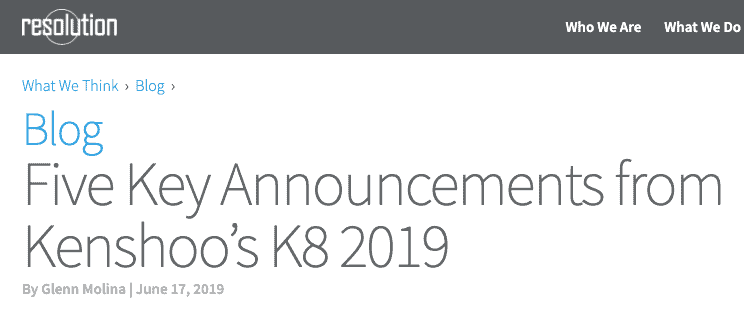K8 announcement followup. Upon returning to work after attending Skai’s annual client summit this year, Resolution’s Glenn Molina detailed some of the innovative things we are working on. We loved his analysis of our roadmap so asked him for an interview to dive deeper.
We recently held our annual client summit K8 West at the Filoli gardens, a beautiful 654-acre estate, located in Woodside, California, about 25 miles south of San Francisco.

One of our attendees was Resolution’s Director of Search Operations, Glenn Molina. Upon his return, Glenn recapped the event with the blog post Five Key Announcements from Skai’s K8 2019.
Glenn Molina’s original post on K8 product announcements
Today, we are going a bit deeper with him on some of the things he covered in his post—not about Skai’s features or products—but on the marketer challenges they are built to solve. Please read Glenn’s post as we ask follow-up questions in the same order as his analysis.
Five Questions with Resolution’s Glenn Molina on His Five Key Announcements from the K8 2019 Summit
K8 2019 Announcement #1 – Skai Navigator
Skai: You mentioned in your post about how this tool is built to execute incrementality tests at scale and how “…the key goal of these tests is to surface insights across all channels, which can then be pushed through the tool into live campaigns.” What is the advantage for a marketer to have measurement be fed directly into in-flight marketing versus post-campaign analysis as measurement is generally done today?
Glenn: Having real-time activation of data is huge for marketers. The ability to observe and measure performance across multiple channels in real-time and then activate against the insights enables marketers to act nimbly and react to present market conditions. Waiting for post-mortem analysis gives insight into why certain situations happened, but real-time measurement can help enhance and improve the successes that a campaign experiences in the present.
K8 2019 Announcement #2 – Upcoming Data Intelligence Applications
Kenshoo: You talked about some of our machine-learning capabilities. From a broad sense, in what area do you feel that marketers are most hopeful for in terms of how AI and machine learning have the potential to transform advertising?
Glenn: AI and machine learning can make a significant impact on campaign management. With cross-device campaigns and increasing numbers of media formats, chances are that most marketers manage campaigns across multiple channels. The scale of these campaigns can make it difficult to manually track performance, leading to a heavy reliance on automation. We’ll have to think of new ways to monitor the decisions that machines make, which can fundamentally change the whole optimization process; it’s no longer just adjusting a bid or pausing a keyword. AI can potentially determine the performance of what’s been viewed as a ‘poor performer’ in a last-touch attribution world as an integral part of a downstream conversion. With the current scale of digital campaigns, marketers can better uncover those insights via AI and machine learning.
K8 2019 Announcement #3 – Skai Audit
Skai: From your post: “While Google’s Optimization Score provides recommendations on how to improve an account, Skai Audit will provide a third-party view into an account, allowing for another level of governance.” Digital marketing has ushered in an era of deeper partnerships with publishers than ever before. How does a marketer successfully balance being both a buyer and a partner with the same company?
Glenn: It really depends on the scale of the buyer/partner. The goals of brands can help drive a publisher’s development roadmap, which then can scale across the publisher’s product offering. We’ve all seen betas that were complete duds that didn’t address the needs of buyers. It comes down blending the audiences and insights the publishers are gathering with the goals of brands. Marketers provide the translation strategy to make sure both work toward the common goal.
K8 2019 Announcement #4 – Apple Ads
Skai: Apple Search Ads are one of the hottest new channels in advertising. A recent eMarketer report said, “Americans spend the overwhelming majority of their mobile time within apps (86%), but many retailers remain focused on the mobile web.” Why do you think that marketers seemed misaligned in their mobile strategy based on where consumers are actually spending the majority of their time?
Glenn: Part of it has to do with the fact that the actual brands don’t know what to do with their own apps. Those brands have apps that haven’t made their way into their audiences’ clickstream. Even social media apps will mostly redirect to mobile web for conversions. The space can get pretty complicated and, until recently, still had heavy black-hat measurement strategies which probably deterred some brands. As brands have started to figure out how to increase usage with loyalists, the insights they get from repeated usage should guide how they develop the main goals of their apps. Once those goals are defined, marketers will start driving toward them.
K8 2019 Announcement #5 – Cross-Channel Audiences
Kenshoo: You wrote about our support for cross-channel audiences—being able to target Search web visitors on Social and vice-versa. How do marketers think about the interplay between these two dominant online marketing channels in terms of driving business goals in tandem?
Glenn: It comes down to what each channel does best for driving business goals. Last-touch reporting kept marketers in their individual swim lanes, and we’ve learned that they all need to play together. Even search and social are really comprised of “mini-channels” which increases the number of paid touchpoints marketers can leverage. The big partners have started offering greater transparency, but marketers still need to increase tracking to make sure they align best with their overarching media mix.







